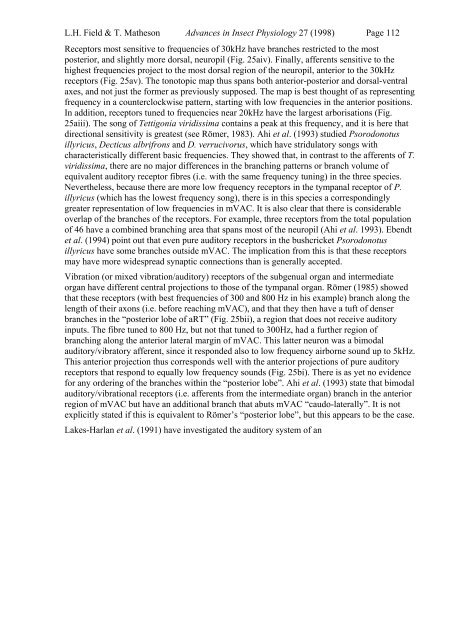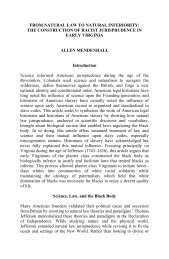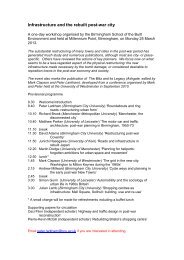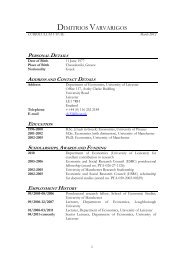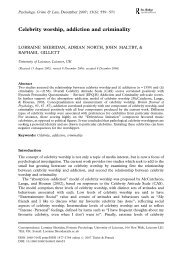Chordotonal Organs of Insects
Chordotonal Organs of Insects
Chordotonal Organs of Insects
Create successful ePaper yourself
Turn your PDF publications into a flip-book with our unique Google optimized e-Paper software.
L.H. Field & T. Matheson Advances in Insect Physiology 27 (1998) Page 112Receptors most sensitive to frequencies <strong>of</strong> 30kHz have branches restricted to the mostposterior, and slightly more dorsal, neuropil (Fig. 25aiv). Finally, afferents sensitive to thehighest frequencies project to the most dorsal region <strong>of</strong> the neuropil, anterior to the 30kHzreceptors (Fig. 25av). The tonotopic map thus spans both anterior-posterior and dorsal-ventralaxes, and not just the former as previously supposed. The map is best thought <strong>of</strong> as representingfrequency in a counterclockwise pattern, starting with low frequencies in the anterior positions.In addition, receptors tuned to frequencies near 20kHz have the largest arborisations (Fig.25aiii). The song <strong>of</strong> Tettigonia viridissima contains a peak at this frequency, and it is here thatdirectional sensitivity is greatest (see Römer, 1983). Ahi et al. (1993) studied Psorodonotusillyricus, Decticus albrifrons and D. verrucivorus, which have stridulatory songs withcharacteristically different basic frequencies. They showed that, in contrast to the afferents <strong>of</strong> T.viridissima, there are no major differences in the branching patterns or branch volume <strong>of</strong>equivalent auditory receptor fibres (i.e. with the same frequency tuning) in the three species.Nevertheless, because there are more low frequency receptors in the tympanal receptor <strong>of</strong> P.illyricus (which has the lowest frequency song), there is in this species a correspondinglygreater representation <strong>of</strong> low frequencies in mVAC. It is also clear that there is considerableoverlap <strong>of</strong> the branches <strong>of</strong> the receptors. For example, three receptors from the total population<strong>of</strong> 46 have a combined branching area that spans most <strong>of</strong> the neuropil (Ahi et al. 1993). Ebendtet al. (1994) point out that even pure auditory receptors in the bushcricket Psorodonotusillyricus have some branches outside mVAC. The implication from this is that these receptorsmay have more widespread synaptic connections than is generally accepted.Vibration (or mixed vibration/auditory) receptors <strong>of</strong> the subgenual organ and intermediateorgan have different central projections to those <strong>of</strong> the tympanal organ. Römer (1985) showedthat these receptors (with best frequencies <strong>of</strong> 300 and 800 Hz in his example) branch along thelength <strong>of</strong> their axons (i.e. before reaching mVAC), and that they then have a tuft <strong>of</strong> denserbranches in the “posterior lobe <strong>of</strong> aRT” (Fig. 25bii), a region that does not receive auditoryinputs. The fibre tuned to 800 Hz, but not that tuned to 300Hz, had a further region <strong>of</strong>branching along the anterior lateral margin <strong>of</strong> mVAC. This latter neuron was a bimodalauditory/vibratory afferent, since it responded also to low frequency airborne sound up to 5kHz.This anterior projection thus corresponds well with the anterior projections <strong>of</strong> pure auditoryreceptors that respond to equally low frequency sounds (Fig. 25bi). There is as yet no evidencefor any ordering <strong>of</strong> the branches within the “posterior lobe”. Ahi et al. (1993) state that bimodalauditory/vibrational receptors (i.e. afferents from the intermediate organ) branch in the anteriorregion <strong>of</strong> mVAC but have an additional branch that abuts mVAC “caudo-laterally”. It is notexplicitly stated if this is equivalent to Römer’s “posterior lobe”, but this appears to be the case.Lakes-Harlan et al. (1991) have investigated the auditory system <strong>of</strong> an


